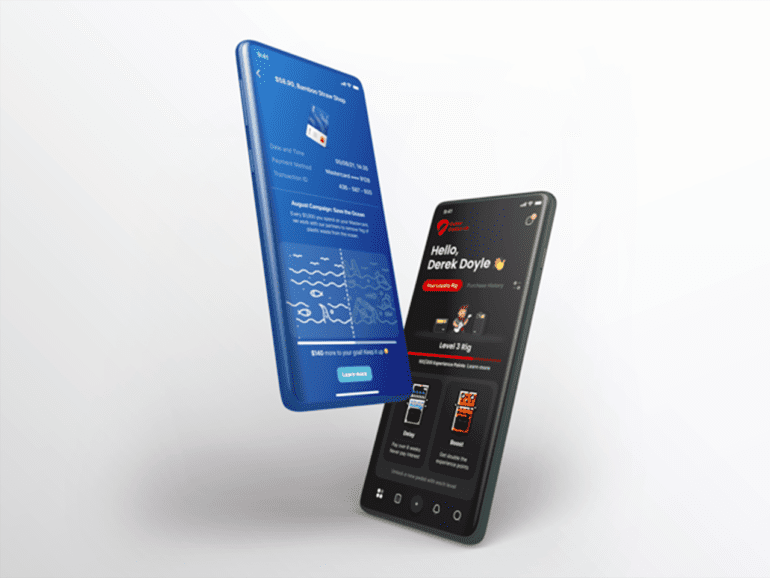While much innovation in fintech over the past decade has improved payment processes, companies have devoted comparatively little focus to receipting.
Chris Boncimino and Flow Networks are changing that.
Founded in early 2021, Flow Networks helps connect the world’s biggest payment systems to the consumer at the moment of payment. They use that period to connect with customers via gamification in ways that build retention.

Boncimino describes himself as a lifetime payments guy. He interned at Discover before moving on to Chase and PayPal.
He was part of the team that put the US Federal Reserve payment system online.
His work with Visa also took him across the world, including Asia, where he gained valuable insights on how brands digitally interact with their customer base.
Clients often asked Boncimino how Alipay and WeChat Pay went from nothing to a commanding market presence in less than a decade.
So he’d show them. For a full day, they’d take their phones out and walk around Beijing or Shanghai and watch how people interacted with brands on their devices.
“We’d show them all of these super relevant, engaging payment times,” Boncimino said. “We called them engagements and put them on the screen, but there are hundreds of them. You pay, and your phone lights up for and with you.”
Asian commerce advanced
In so many ways, Asian commerce is much more advanced in how it digitally interacts with consumers via their mobiles than in the West.
Boncimino could see it, and he wanted to bring that capability to the United States.
While plenty of innovation was occurring, no one was looking at that short window during the payment completion process, which wasted time, but for Boncimino, opportunity.
In Asia, he saw apps that let people grow trees with every payment.
They could compete against their friends, steal energy from them and grow their trees faster. Once the trees reached a certain point, the sponsoring company would plant an actual tree.
Another concept was a shovel. The customer would get a shovel with every payment, which increased capability through added functionalities as the app was used more.
There were also digital scratch cards, punch cards, and red envelopes that could reveal rewards.
“All these tools are designed for habituation around the payment method,” Boncimino said.
And it also ties in with our growing environmental sensitivity, Boncimino noted.
He shared a story about taking his kids for ice cream and being asked if he wanted the receipt. He, of course, said no, and the receipt went into the garbage with dozens of other receipts produced that day.
That paper adds up to millions of trees and millions of gallons of water used every year — a complete waste given the level of technology available to us.
With Flow Networks, consumers can select how they want to receive their receipt if they even want it at all.
They can say “no receipt,” get it emailed to them or have it stored in a digitally secure repository.
That process alone reduces the potential for fraud because less personally identifiable information is being transmitted less often.
That was the experience in Asia, where people were much more comfortable making digital debit payments than in North America, yet they experienced much less fraud.
Debit cards safe online
“People don’t spend as much online with their debit cards thinking it’s unsafe,” Boncimino said. “It’s totally safe. They just don’t do it. So you need to drive those messages to say it’s safe and see what we’re doing here.”
“You know what Flow is? To me, it’s the culmination of these learnings, these lessons about where I believe the puck is going in payments, this inevitability about consumer engagement now that we’re off, we’re moving quickly off cards to devices, this inevitability of engagement might be more powerful and cashback rewards.”
“We should get the garbage out of the payment process to be full digital because when things go full digital, it’s better.”
And when you go digital, you can engage your customers at what had previously been dead points in the process. Choosing from a series of playbooks, brands can decide how they want to interact with customers.
Perhaps that ice cream shop wants to keep that new customer by providing a digital scratch-off that gives a free topping, or the retailer will grow the customer’s virtual tree twice as fast with purchases from certain categories at certain times.
While there are many options, each keeps the issuer in control of the engagement and not some outside tech company, Boncimino said.
“We seem to take this disregarded moment that we have today. You know it’s a blip where your adrenaline spikes, money is leaving, and we just don’t really register it when it’s a plastic card but as it moves to a digital thing, take that blip and harness it, use it, connect. It happens a billion times, they connect the unconnected. Flow is a platform that gives tools to issuers to make use of that payment moment.”
Fraud will decline
Grow your tree, plant a tree. Fish plastic out of the oceans. Promote buy now, pay later options. If none of this catches your imagination, try fraud, Boncimino suggested.
With people engaged during this part of the process, the opportunity for fraud declines, possibly as low as it is in Asia vis-a-vis North America.
Rewind to the ice cream guy pitching another receipt in the trash. Erase that and give the merchant the ability to have the receipt encrypted on the back end and placed in a vault.
The issuer gets a webhook notice that there’s a receipt waiting for them which they can pull out of the vault decrypted.
Flow Networks never looks at the receipt and cannot decrypt a receipt — only the issuer has that ability.
“They display it in their web experience and their app experience,” Boncimino said.
“You can put it in the statements and we think this super powerful thing over time for retention and issuer portfolios, enough that they should pay for it. We are building this business that we can do it independently, receipt side action because there are other receipt companies out there, and from engagement side action, but it’s so much better when it’s together.”
These interactions are short, maybe 20 seconds in length, Boncimino said. Long enough to retain and be effective, but not so long as to be an annoyance.
The offer may have a countdown. It’s’ classic gamification, he added and it’s’ irresistible. The merchant provides, logos, colors and other parameters and Flow incorporates into a branded experience.
“The issuer doesn’t really have to do any work,” Boncimino said. “The merchant on our merchant site gives us in this case, coupon codes, promo codes, they can give us 2D barcodes that the merchant can scan.”
Real-time engagement
Flow Networks’ real-time engagement is so promising, it was one of the few deals that Visa chose to activate during the most recent Olympics, Boncimino said.
Through a series of 20-25-second games, cardholders could interact at the point of sale, while earning points and pursuing a spot on the podium for your country.
“The dwell time on this thing was fantastic,” Boncimino said. “(People) spent a lot more time in the app and it’s because they went back to the leaderboard to see where they were. We’re super proud of this work.”


